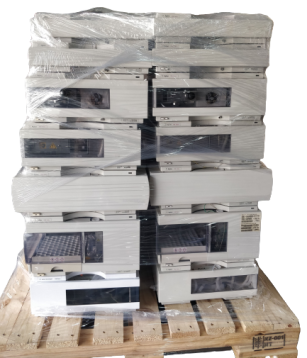Although it’s a hassle, relocation is just a part of life. Sometimes, this means packing up your current laboratory and moving all the equipment and chemicals to a new location. Whether your destination is another country or just down the corridor, this article covers the best tips for relocating a laboratory, from researchers and lab managers who have made the move before
Hire a Moving Company
If you’re moving down the road, relocating your lab through several short trips in your car is perfectly fine. But if your destination is further away, especially if it’s a place you aren’t familiar with, it’s best to get a moving company to help.
Yes, I get it. You don’t trust movers to handle your expensive equipment and glassware safely, and there’s no way you’re letting them anywhere near your research samples—the result of years of hard work!
On the other hand, hiring movers means you don’t have to worry about car problems and random checks by officials. You don’t want to be stopped for questioning with your trunk full of dangerous chemicals and controlled substances, even if you do have the license to possess them.
Reputable moving companies often train their staff to handle fragile equipment, such as using cling wrap and wooden pallets to secure them (the picture below shows my HPLC units on a wooden pallet and ready for transport). Some services also specialize in laboratory and chemical relocation, providing cold chains that ensure uninterrupted low-temperature transport.

Insurance isn’t Just for Cars
While investing in a ton of bubble wrap can help ease your mind, you can also take out insurance on the most valuable items. Some moving companies have built-in insurance plans, but they may not cover dangerous or hazardous goods and high-value laboratory equipment.
Whether you choose to buy insurance from the moving company or an external insurance provider, ensure you get the paperwork stamped and in hand before any work is done. An added tip is to have a camera running as you unseal each box at your destination as evidence for any claims you might need to make. You can also film when powering equipment for the first time.
Try to Plan Renovations Before the Move
Downtime is no fun; in an ideal world, you’d be up and running the moment you set foot into your new lab. Unpacking and assembling everything takes time, but even this will be further delayed if renovations aren’t complete when you arrive.
If possible, take a trip (or multiple trips) to your new laboratory to look for potential areas that may need renovations and repairs—older labs always need new hardware fittings. If a physical trip isn’t possible (if you’re moving to another country, for example), you can always request floor plans that include electrical diagrams, gas lines, HVAC runs and water plumbing.
Make Sure Utilities are Up and Running
Imagine unpacking all that equipment in your new lab, only to realize that you can’t start your experiments because the power isn’t connected! Make sure that water, electricity and gas lines (actual gas, nitrogen, helium, oxygen, etc.) are also turned on before you get there to ensure a smooth transition.
One crucial point to check for is the power rating. If you’re moving overseas, the destination country may not have power outlets rated for the equipment you current have in the lab. U.S.-bought equipment operates on 110V/120V AC 60Hz, while most other countries use 220/240 Volts AC 50Hz. You might need to buy voltage transformers to either step up or down the voltage accordingly.

Having a utility-ready lab is essential for freezers and refrigerators! Many chemical and biological samples don’t do well at room temperature, so ensure the lab is ready for them when they arrive. This might mean having backup power on standby in case of any hitches. There’s no worse feeling than watching years of hard work slowly thawing away…
Recalibrate Equipment at Your New Lab
Most equipment isn’t meant to be shifted from their spot in the lab, which can affect their mechanisms. This is especially true for moving lab equipment with sensitive internal parts like weighing balances or an NMR machine (oh boy). To avoid errors in your experimental data, it’s a good idea to recalibrate each piece of equipment right after relocation.
To reduce downtime, inform vendors and service technicians of your move beforehand. Trust me; planners love it when you tell them your needs in advance—the earlier, the better. You’ll also avoid the stress of scheduling urgent vendor visits while setting up your new lab. Take this time to build relationships with the local service staff for the equipment before your schedule becomes too tight.
Label Your Boxes (and Count Them)
We all know that labeling is essential; otherwise, you’ll be spending time identifying hundreds of pieces of specialized glassware and obscure laboratory equipment parts. One tip is to label where things are (in your current lab) and not where you imagine they will go (in your future lab).
Being familiar with your current lab means you’ll have a mental map of everything, whereas you might not have a clear picture of workflows at your new workplace. Labeling your boxes based on their contents’ current location helps you visualize what you have, where they should belong and how accessible they will need to be after you set foot in your new laboratory.
This is where checklists or a system of numbers comes in handy. By accounting for every box going in and out of the lab, you’ll save yourself the surprise of opening a box years later and saying, ‘so it was in here all along!’
Be Careful of Moving Parts
Take extra care if you’re moving entire cabinets without first transferring their contents into boxes. First, ensure that any fragile contents won’t knock on the sides of the container and each other. If they do, you should wrap them with newspaper or bubble wrap, using the excess to fill spaces in the container.
Make sure the smaller parts won’t fall into the back of the cabinet, where it’ll be a pain to retrieve later on. Finally, ensure that drawers and trays are taped shut securely; otherwise, they’ll come flying off the rails in transit.
Segregate Chemicals While Packing
You must keep incompatible groups apart during transport if your lab deals with chemicals! These include acids/bases, flammables/oxidizers, oxidizing/reducing agents, etc. For a list of specific substances and their incompatibilities, the University of Glasgow maintains a valuable resource.
If you choose to move your lab’s reagents in your vehicle, please store them in your trunk and not on a passenger seat (for apparent reasons…). Remember that transporting flammable substances might require a license, depending on your location. Again, moving companies often have expertise in this area.
Give Your Team Time to Plan
Finally, inform your team as soon as possible! This is especially important if you’ve accepted an offer outside your institution and your new lab is some distance away. As the lab manager/PI, moving your lab to another institute might be an incredible opportunity, but it also significantly impacts the rest of your team.
If any team members make the move, it will involve uprooting their current lives (and their partners/dependents, if any). Giving them extra time to decide on and plan their relocation will make their move as smooth as possible.
Even if they choose not to follow, you should help them identify other work opportunities. For graduate students, this means looking for another group within the university/institute that will take them under their wing till the end of their project.
Moving to a New Lab is a Fresh Start!
While it’s definitely a stressful time, moving does have its benefits. One positive about packing up and moving is that it forces you to plan and organize where equipment and reagents go. Take this opportunity to implement the 5S method, which will improve safety and productivity at your new lab. You can do this before you unpack, giving you a fresh slate to plan your workflows!
Whether you’re a principal investigator, a laboratory manager, a researcher or a graduate student, everyone pitches in when the entire laboratory must be relocated. When you think about it, it’s a great team-building activity. While moving your lab no doubt causes stress, you can rest a little easier by focusing on the positives instead (and following these tips, of course). Good luck!
We’ve also provided a checklist for easy copy/paste into a moving plan (that you no doubt already have):
Checklist for Laboratory Relocation
- Hire a moving company to handle the heavy lifting
- Take out insurance for high-value items and equipment
- Renovate before you arrive at your new lab
- Ensure utilities (gas, power, water) are up and running
- Laboratory equipment power rating check
- Plan a recalibration schedule for your equipment
- Label boxes—and know how many you have
- Inform your team early!
About the Author

Sean is a consultant for clients in the pharmaceutical industry and is an associate lecturer at La Trobe University, where unfortunate undergrads are subject to his ramblings on chemistry and pharmacology.



